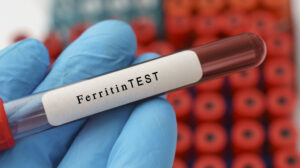In both North America and Europe, whole blood donors are eligible to donate whole blood every 56 days. Donors lose 220-250 mg of iron with each whole-blood donation, and low hemoglobin is the most common reason for donor deferrals. Since 2012, both the World Health Organization (WHO) and the Association for the Advancement of Blood and Biotherapies (AABB) have recommended monitoring ferritin concentrations (a measure of iron stores) in blood donors. Few blood centers, however, measure ferritin levels in donors because it is expensive and cumbersome. In 2017, the Netherlands implemented ferritin testing nationwide for donors. The efficacy of this approach was evaluated by using a step-wedge cluster randomized trial design. All 138 blood donation centers in the country were randomly assigned to four groups, and a ferritin-guided donation policy was added one group at a time (in periods of six months) over three years, in addition to the standard hemoglobin-based screening and deferral. Ferritin levels were tested for all new donors and every fifth donation for repeat donors. Subsequent donation intervals were increased to six months if ferritin levels were 15 to 30 ng/mL and to 12 months if levels were <15 ng/mL. Of the 414,130 whole blood donations in the Netherlands from September 2017 to November 2020, 37,621 donations from 36,099 donors were assessed. Compared with standard hemoglobin-based deferral, ferritin-guided donation intervals were associated with significantly higher ferritin and hemoglobin levels and decreased iron deficiency among all donors (men, pre- and post-menopausal women). In addition, hemoglobin deferrals for men decreased and stayed steady for women after ferritin-guided donation intervals were implemented. The risk of losing donors (men and post-menopausal women), however, increased after the policy was implemented. While ferritin-guided donation intervals may be beneficial to preserve iron stores in donors, increased efforts to retain donors are needed.
References:
- Meulenbeld A, Ramondt S, Sweegers MG, Quee FA, et al. Effectiveness of ferritin-guided donation intervals in whole-blood donors in the Netherlands (FIND’EM): a stepped-wedge cluster-randomized trial. The Lancet 2024
- Infanti L. Protecting the blood donor: ferritin-based intervals to improve donor health. The Lancet 2024

